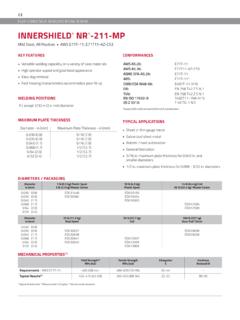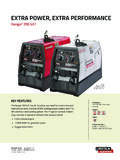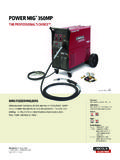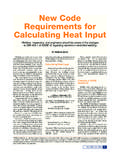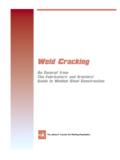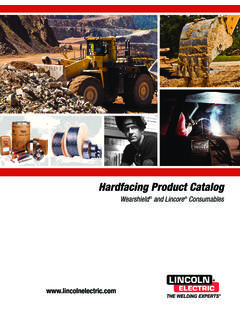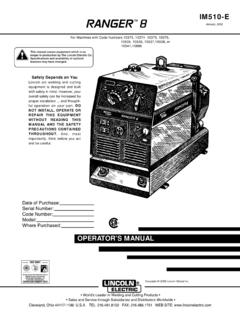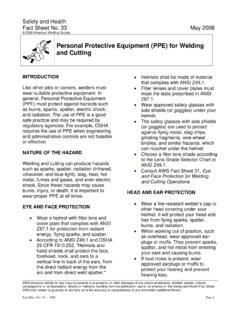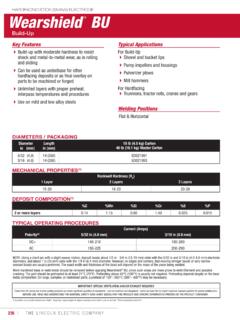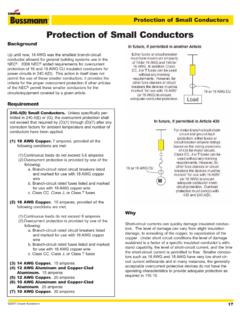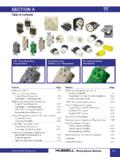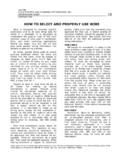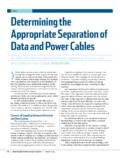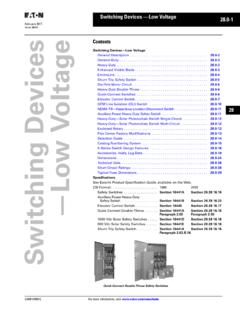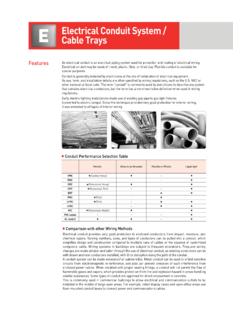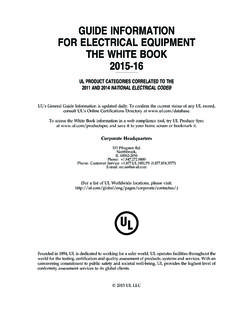Transcription of Grounding of Portable and Vehicle Mounted …
1 Safety and Health Fact Sheet No. 29 July 2004 2004 American Welding Society GND/PE Grounding of Portable and Vehicle Mounted Welding Generators AWS disclaims liability for any injury to persons or to property, or other damages of any nature whatsoever, whether special, indirect, consequential or compensatory, directly or indirectly resulting from the publication, use of, or reliance on this Safety and Health Fact Sheet. AWS also makes no guaranty or warranty as to the accuracy or completeness of any information published herein. Fact Sheet No. 29 07/04 Page 1 INTRODUCTION Proper Grounding and bonding of Portable and Vehicle Mounted welding generators that also supply 115 or 230 volts AC auxiliary power is an on-going topic among welders.
2 This Fact Sheet will help you determine the requirements for bonding and Grounding welding generators. Additionally, it will give definitions and present necessary electrical concepts to clarify the requirements for bonding and Grounding . TERMS Sources: ANSI , hereafter termed , AWS , and NEC--National Electrical Code, hereafter termed NEC. See Information Sources Section at end for details. Bonding The permanent joining of metallic parts to form an electrically conductive path that will ensure electrical continuity and the capacity to conduct safely any current likely to be imposed. Ground The electrical potential of the earth s surface; a conducting connection, whether intentional or accidental, between an electrical circuit or equipment and the earth, or to some conducting body that serves in place of the earth.
3 Ground Connection An electrical con- nection of the welding machine frame to the earth for safety. Grounded Connected to earth or to some conducting body that serves in place of the earth. Grounded, effectively Intentionally con- nected to earth through a ground connection of sufficiently low resistance and with adequate current-carrying capacity to prevent the buildup of voltage that may be hazardous to connected equipment or to persons. Grounding The process of bonding one or more conductive objects to the ground, so that all objects are at zero (O) electrical potential; also referred to as earthing. Grounding Conductor A conductor used to connect equipment or the grounded circuit of a wiring system to a Grounding electrode or electrodes [ground rod(s) or metal water pipe].
4 Ground Rod A metal rod, typically copper, not less than eight feet in length and 1/2 inch in diameter, driven into the earth such that at least eight feet of length is in contact with the soil, to function as a suitable connection point to earth. NOTE: Since different diameters are required for different rod materials and the driven length and number of rods used depends on the special soil conditions and applications, consult the NEC for the specific data for the correct ground rod and method of use for each particular situation. AWS disclaims liability for any injury to persons or to property, or other damages of any nature whatsoever, whether special, indirect, consequential or compensatory, directly or indirectly resulting from the publication, use of, or reliance on this Safety and Health Fact Sheet.
5 AWS also makes no guaranty or warranty as to the accuracy or completeness of any information published herein. Fact Sheet No. 29 07/04 Page 2 Hard Wired Connected by separate conductors to a junction point or box not to receptacles. Metal Water Pipe Typically an under- ground metal water pipe that supplies water to a building or premises or faucet /outlet and that is in contact with the earth for a specified distance. NOTE: Since the metal water pipe has several key requirements that must be met before it complies with regulations, consult the NEC for specific information before selecting any pipe for a ground connection.
6 Portable Capable of being carried or moved about; designed for ready movement and use in field locations. Separately Derived System--A premises wiring system whose power is derived from a battery, a solar photovoltaic system, or from a generator, transformer, or converter windings, and that has no direct electrical connection, including a solidly connected grounded circuit conductor, to supply conductors originating in another system. Vehicle Mounted Equipment installed in a truck, trailer, or similar wheeled Vehicle . Work The workpiece or metal upon which the welder welds and is normally grounded independently of the welding leads to a good electrical ground unless a qualified person assures it is safe to work on an ungrounded workpiece.
7 Work Lead The electric conductor be- tween the source of arc welding current and the work. The work lead should not be referred to as the ground lead. It is preferable to connect the work lead directly to the work. Unless a separate Grounding conductor is used (to connect the workpiece to an earth ground), the work lead will not be grounded. NATURE OF THE HAZARD Some basics: When the generator is running, current can pass through a wire, a ladder, a hoist, your body, or any other conductor. If you become part of an electrical circuit, current can pass through your body causing a shock. Why Grounding is Important: Grounding the frame of electrical equipment ensures the following: Generators are grounded to prevent the buildup of voltages that may result in undue hazards to persons or equipment.
8 When no voltage difference exists between the grounded generator frame and earth, no electric current can flow. Therefore, the shock hazard is reduced. Since it is the flow of electric current through the human body that is hazardous, proper Grounding is one of the best ways to prevent unintended electric shock. If we don t ground the generator and should have, the results can be hazardous here s why: If the auxiliary power circuit has a fault condition (such as a short caused by bare wires), and there is no safety ground connection to protect the user, the result can be an electric shock. Additionally, Grounding helps prevent possible fire or explosion when fueling by reducing the chances for static electricity sparks from the fuel nozzle to the tank.
9 AWS disclaims liability for any injury to persons or to property, or other damages of any nature whatsoever, whether special, indirect, consequential or compensatory, directly or indirectly resulting from the publication, use of, or reliance on this Safety and Health Fact Sheet. AWS also makes no guaranty or warranty as to the accuracy or completeness of any information published herein. Fact Sheet No. 29 07/04 Page 3 CONDITIONS WHERE Grounding THE GENERATOR FRAME TO A METAL WATER PIPE OR GROUND ROD IS REQUIRED BY THE NEC: 1. The welding generator is not part of a separately derived system, OR 2.
10 It has its neutral conductor solidly interconnected to a service-supplied system neutral, OR 3. It supplies auxiliary power output (115 volts AC / 230 volts AC) by means other than cord-and-plug connection through receptacles Mounted on the generator, such as connections to internal terminals on the generator hard wired (see equipment Owner s Manual for Grounding instructions). When ANY of these conditions are met, Grounding is required. CONDITIONS WHERE Grounding THE GENERATOR FRAME TO A METAL WATER PIPE OR GROUND ROD IS NOT REQUIRED BY THE NEC: 1. The welding generator has auxiliary power output (115 volts AC or 230 volts AC) and the generator receptacles have a ground pin outlet available for the equipment that plugs into the receptacle, AND 2.
